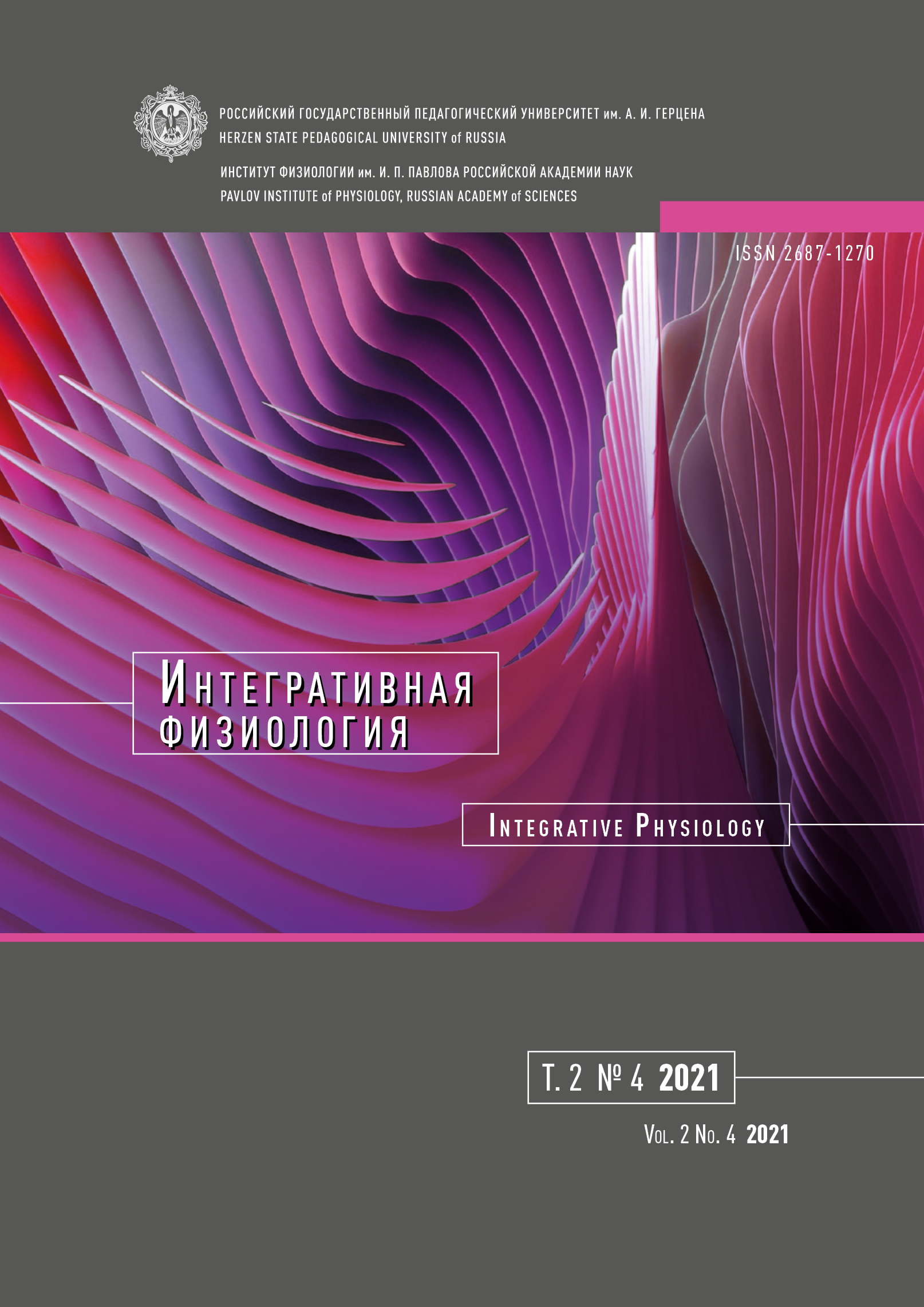Нестероидные противовоспалительные препараты: повреждающее действие на слизистую оболочку желудка и способы защиты от их ульцерогенного влияния
DOI:
https://doi.org/10.33910/2687-1270-2021-2-4-390-398Ключевые слова:
нестероидные противовоспалительные препараты, желудочно-кишечный тракт, повреждения слизистой оболочки, простагландины, глюкокортикоидные гормоны, гастропротекцияАннотация
Нестероидные противовоспалительные препараты (НСПВП) применяют при различных заболеваниях для снятия боли и уменьшения воспалительного процесса. Однако применение НСПВП может приводить к нежелательным побочным эффектам на почки, сердце, желудочно-кишечный тракт (ЖКТ) и центральную нервную систему, что существенно осложняет использование этих препаратов в клинике. В обзоре проанализированы данные литературы о противовоспалительном действии НСПВП и их нежелательных побочных эффектах. Особое внимание уделяется неблагоприятному действию НСПВП на ЖКТ. Прием НСПВП может приводить к появлению диспептических симптомов, гастропатии, повреждениям слизистых оболочек ЖКТ, в том числе эрозиям и язвам, которые могут сопровождаться желудочно-кишечными кровотечениями и перфорациями. Механизмы повреждения желудка при действии НСПВП включают уменьшение кровотока в слизистой оболочке, увеличение проницаемости микрососудов, снижение секреции слизи и бикарбонатов, изменение перекисного окисления липидов с разрушением структуры клеточных мембран. Ярко выраженным ульцерогенным действием обладают неселективные НСПВП, среди которых индометацин и аспирин. Повреждающее действие ЦОГ-2 селективных НСПВП на слизистые оболочки ЖКТ выражено в меньшей степени, чем неселективных, однако они могут приводить к серьезным кардиологическим проблемам. Для снижения ульцерогенного эффекта НСПВП применяют средства, понижающие секрецию соляной кислоты в желудке, препараты, ассоциированные с мембранными фосфолипидами и содержащие в своей структуре оксид азота и сероводород. Прием НСПВП увеличивает уровень глюкокортикоидных гормонов в крови, которые компенсируют отсутствие простагландинов и оказывают гастропротективный эффект. Физическая нагрузка стимулирует естественные защитные факторы организма и защищает слизистую оболочку желудка от воздействия НСПВП. В связи с этим обстоятельством выяснение механизмов ульцерогенного действия НСПВП на ЖКТ и гастропротективных механизмов, противостоящих этому повреждающему действию, разработка научно обоснованных подходов для уменьшения негативного влияния препаратов данной группы является важной задачей и требует дальнейших физиологических исследований.
Библиографические ссылки
Ahmed, E. M., Kassab, A. E., El-Malah, A. A., Hassan, M. S. A. (2019) Synthesis and biological evaluation of pyridazinone derivatives as selective COX-2 inhibitors and potential anti-inflammatory agents. European Journal of Medicinal Chemistry, vol. 171, pp. 25–37. https://doi.org/10.1016/j.ejmech.2019.03.036 (In English)
Arias, L. H. M, González, A. M., Fadrique, S. R., Vazquez, E. S. (2019) Cardiovascular risk of nonsteroidal anti-inflammatory drugs and classical and selective cyclooxygenase-2 inhibitors: A meta-analysis of observational studies. Journal of Clinical Pharmacology, vol. 59, no. 1, pp. 55–73. https://doi.org/10.1002/jcph.1302 (In English)
Banick, P. D., Chen, Q., Xu, Y. A., Thom, S. R. (1997) Nitric oxide inhibits neutrophil beta 2 integrin function by inhibiting membrane-associated cyclic GMP synthesis. Journal of Cellular Physiology, vol. 172, no. 1, pp. 12–24. https://doi.org/10.1002/(SICI)1097-4652(199707)172:1<12::AID-JCP2>3.0.CO;2-G (In English)
Bjarnason, I., Scarpignato, C., Holmgren, E. et al. (2018) Mechanisms of damage to the gastrointestinal tract from nonsteroidal anti-inflammatory drugs. Gastroenterology, vol. 154, no. 3, pp. 500–514. https://doi.org/10.1053/j. gastro.2017.10.049 (In English)
Blackler, R. W., Palma, G. D., Manko, A. et al. (2015) Deciphering the pathogenesis of NSAID enteropathy using proton pump inhibitors and a hydrogen sulfide-releasing NSAID. American Journal of Physiology — Gastrointestinal and Liver Physiology, vol. 308, no. 12, pp. G994–1003. https://doi.org/10.1152/ajpgi.00066.2015 (In English)
Brown, J. F., Hanson, P. J., Whittle, B. J. R. (1993) The nitric oxide donor, S-nitroso-N-acetyl-penicillamine, inhibits secretory activity in rat isolated parietal cells. Biochemical and Biophysical Research Communications, vol. 195, no. 3, pp. 1354–1359. https://doi.org/10.1006/bbrc.1993.2192 (In English)
Brusselaers, N., Lagergren, J. (2018) Maintenance use of non-steroidal anti-inflammatory drugs and risk of gastrointestinal cancer in a nationwide population-based cohort study in Sweden. BMJ Open, vol. 8, no. 7, article e021869. https://doi.org/10.1136/bmjopen-2018-021869 (In English)
Brzozowski, T. (2010) Nonsteroidal anti-inflammatory drug-induced experimental gastropathy: Is gastric acid the major trigger? Clinical and Experimental Pharmacology and Physiology, vol. 37, no. 7, pp. 651–653. https://doi.org/10.1111/j.1440-1681.2010.05392.x (In English)
Cooper, T. E., Heathcote, L. C., Anderson, B. et al. (2017) Non-steroidal anti-inflammatory drugs (NSAIDs) for cancer-related pain in children and adolescents. Cochrane Database of Systematic Reviews, vol. 7, no. 7, article CD012563. https://doi.org/10.1002/14651858.CD012563.pub2 (In English)
Ehrlich, K., Sicking, C., Respondek, M., Peskar, B. M. (2004) Interaction of cyclooxygenase isoenzymes, nitric oxide, and afferent neurons in gastric mucosal defence in rats. Journal of Pharmacology and Experimental Therapeutics, vol. 308, no. 1, pp. 277–283. https://doi.org/10.1124/jpet.103.057752 (In English)
Esplugues, J. V., Barrachina, M. D., Beltran, B. et al. (1996) Inhibition of gastric acid secretion by stress: A protective reflex mediated by cerebral nitric oxide. Proceedings of the National Academy of Sciences of the USA, vol. 93, no. 25, pp. 14839-14844. https://doi.org/10.1073/pnas.93.25.14839 (In English)
Fang, Y. F., Xu, W. L., Wang, L. et al. (2019) Effect of hydrotalcite on indometacin-induced gastric injury in rats. BioMed Research International, vol. 2019, article 4605748. https://doi.org/10.1155/2019/4605748 (In English)
Filaretova, L. P., Bagaeva, T. R., Makara, G. B. (2002a) Aggravation of nonsteroidal antiinflammatory drug gastropathy by glucocorticoid deficiency or blockade of glucocorticoid receptor in rats. Life Science, vol. 71, no. 21, pp. 2457–2468. https://doi.org/10.1016/s0024-3205(02)02078-7 (In English)
Filaretova, L., Bobryshev, P., Bagaeva, T. et al. (2007) Compensatory gastroprotective role of glucocorticoid hormones during inhibition of prostaglandin and nitric oxide production and desensitization of capsaicin-sensitive sensory neurons. Inflammopharmacology, vol. 15, no. 4, pp. 146–153. https://doi.org/10.1007/s10787-007-1589-x (In English)
Filaretova, L., Tanaka, A., Miyazawa, T. et al. (2002b) Mechanisms by which endogenous glucocorticoids protects against indomethacin-induced gastric injury in rats. American Journal of Physiology — Gastrointestinal and Liver Physiology, vol. 283, no. 5, pp. G1082–G1089. https://doi.org/10.1152/ajpgi.00189.2002 (In English)
García-Rayado, G., Sostres, C., Lanas, A. (2017) Aspirin and omeprazole for secondary prevention of cardiovascular disease in patients at risk for aspirin-associated gastric ulcers. Expert Review of Clinical Pharmacology, vol. 10, no. 8, pp. 875–888. https://doi.org/10.1080/17512433.2017.1324782 (In English)
Jung, S-Y., Jang, E. J., Nam, S. W. et al. (2018) Comparative effectiveness of oral pharmacologic interventions for knee osteoarthritis: A network meta-analysis. Modern Rheumatology, vol. 28, no. 6, pp. 1021–1028. https://doi.org/10.1080/14397595.2018.1439694 (In English)
Keller, J., Bassotti, G., Clarke, J. et al. (2018) Advances in the diagnosis and classification of gastric and intestinal motility disorders. Nature Reviews. Gastroenterology and Hepatology, vol. 15, no. 5, pp. 291–308. https://doi.org/10.1038/nrgastro.2018.7 (In English)
Lee, Y-C., Liou, J-M., Wu, C-Y. et al. (2008) Eradication of Helicobacter pylori to prevent gastroduodenal diseases: Hitting more than one bird with the same stone. Therapeutic Advances in Gastroenterology, vol. 1, no. 2, pp. 111–120. https://doi.org/10.1177/1756283X08094880 (In English)
Lichtenberger, L. M., Barron, M. Marathi, U. (2009) Association of phosphatidylcholine and NSAIDs as a novel strategy to reduce gastrointestinal toxicity. Drugs of Today, vol. 45, no. 2, pp. 877–890. https://doi.org/10.1358/dot.2009.45.12.1441075 (In English)
Lichtenberger, L. M., Wang, Z. M., Romero, J. J. et al. (1995) Non-steroidal anti-inflammatory drugs (NSAIDs) associate with zwitterionic phospholipids: Insight into the mechanism and reversal of NSAID-induced gastrointestinal injury. Nature Medicine, vol. 1, no. 2, pp. 154–158. https://doi.org/10.1038/nm0295-154 (In English)
Lichtenberger, L. M., Zhou, Y., Dial, E. J., Raphael, R. M. (2006) NSAID injury to the gastrointestinal tract: Evidence that NSAIDs interact with phospholipids to weaken the hydrophobic surface barrier and induce the formation of unstable pores in membranes. Journal of Pharmacy and Pharmacology, vol. 58, no. 11, pp. 1421–1428. https://doi.org/10.1211/jpp.58.10.0001 (In English)
Magierowski, M., Magierowska, K., Hubalewska-Mazgaj, M. et al. (2017) Carbon monoxide released from its pharmacological donor, tricarbonyldichlororuthenium (II) dimer, accelerates the healing of pre-existing gastric ulcers. British Journal of Pharmacology, vol. 174, no. 20, pp. 3654–3668. https://doi.org/10.1111/bph.13968 (In English)
Marshall, B. J. (1993) Treatment strategies for Helicobacter pylori infection. Gastroenterology Clinics of North America, vol. 22, no. 1, pp. 183–198. (In English)
Mason, L., Edwards, J. E., Moore, R. A. et al. (2004) Single dose oral naproxen and naproxen sodium for acute postoperative pain (Review). Cochrane Database of Systematic Reviews, vol. 4, article CD004234. https://doi.org/10.1002/14651858.CD004234.pub2 (In English)
Minalyan, A., Gabrielyan, L., Scott, D. et al. (2017) The gastric and intestinal microbiome: Role of proton pump inhibitors. Current Gastroenterology Reports, vol. 19, no. 8, article 42. https://doi.org/10.1007/s11894-017-0577-6 (In English)
Nie, S., Yuan, Y. (2020) The role of gastric mucosal immunity in gastric diseases. Journal of Immunology Research, vol. 2020, article 7927054. https://doi.org/10.1155/2020/7927054 (In English)
Okayama, T., Yoshida, N., Uchiyama, K. et al. (2009) Mast cells are involved in the pathogenesis of indomethacin-induced rat enteritis. Journal of Gastroenterology, vol. 44, no. 19, pp. 35–39. https://doi.org/10.1007/s00535-008-2267-5 (In English)
Pai, A. B., Engling, J., Chapman, C. et al. (2019) Patient-selected media and knowledge of risk to kidneys of nonsteroidal anti-inflammatory drugs. Journal of the American Pharmacists Association, vol. 59, no. 3, pp. 329–335. https://doi.org/10.1016/j.japh.2019.01.012 (In English)
Park, K., Bavry, A. A. (2014) Risk of stroke associated with nonsteroidal anti-inflammatory drugs. Vascular Health and Risk Management, vol. 10, pp. 25–32. https://doi.org/10.2147/VHRM.S54159 (In English)
Scheiman, J. M. (2013) The use of proton pump inhibitors in treating and preventing NSAID-induced mucosal damage. Arthritis Research and Therapy, vol. 15, article S5. https://doi.org/10.1186/ar4177 (In English)
Sener, Y. Z., Oksul, M. (2020) Effects of NSAIDs on kidney functions and cardiovascular system. Journal of Clinical Hypertension, vol. 22, no. 2, article 302. https://doi.org/10.1111/jch.13769 (In English)
Singh, V. P., Patil, C. S., Kulkarni, S. K. (2005) Effect of licofelone against NSAIDs-induced gastrointestinal ulceration and inflammation. Indian Journal of Experimental Biology, vol. 43, no. 3, pp. 247–253. PMID: 15816411 (In English)
Sinha, M., Gautam, L., Shukla, P. K. et al. (2013) Current perspectives in NSAID-induced gastropathy. Mediators of Inflammation, vol. 2013, article 258209. https://doi.org/10.1155/2013/258209 (In English)
Takeuchi, K. (2012) Pathogenesis of NSAID-induced gastric damage: Importance of cyclooxygenase inhibition and gastric hypermotility. World Journal of Gastroenterology, vol. 18, no. 18, pp. 2147–2160. https://doi.org/10.3748/wjg.v18.i18.2147 (In English)
Takeuchi, K., Okada, M., Niida, H., Okabe, S. (1990) Possible mechanisms involved in gastric hypermotility caused by indomethacin in the rat. Role of glycoprivic response. Digestive Diseases and Science, vol. 35, no. 8, pp. 984–992. https://doi.org/10.1007/BF01537247 (In English)
Takeuchi, K., Satoh, H. (2015) NSAID-induced small intestinal damage-roles of various pathogenic factors. Digestion, vol. 91, no. 3, pp. 218–232. https://doi.org/10.1159/000374106 (In English)
Vane, J. R., Bakhle, Y. S., Botting, R. M. (1998) Cyclooxygenases 1 and 2. Annual Review of Pharmacology and Toxicology, vol. 38, pp. 97–120. https://doi.org/10.1146/annurev.pharmtox.38.1.97 (In English)
Wallace, J. L. (1997) Nonsteroidal anti-inflammatory drugs and gastroenteropathy: The second hundred years. Gastroenterology, vol. 112, no. 3, pp. 1000–1016. https://doi.org/10.1053/gast.1997.v112.pm9041264 (In English)
Wallace, J. L., Keenan, C. M., Granger, D. N. (1990) Gastric ulceration induced by nonsteroidal anti-inflammatory drugs is a neutrophil-dependent process. American Journal of Physiology — Gastrointestinal and Liver Physiology, vol. 259, no. 3, pp. G462–G467. https://doi.org/10.1152/ajpgi.1990.259.3.G462 (In English)
Wallace, J. L., Pittman, Q. J., Cirino, G. (1995) Nitric oxide releasing NSAIDs: A novel class of GI-sparing anti-inflammatory drugs. Agents and Actions Supplements, vol. 46, pp. 121–129. https://doi.org/10.1007/978-3-0348-7276-8_12 (In English)
Wallace, J. L., Wang, R. (2015) Hydrogen sulfide-based therapeutics: Exploiting a unique but ubiquitous gasotransmitter. Nature Reviews. Drug Discovery, vol. 14, no. 5, pp. 329–345. https://doi.org/10.1038/nrd4433 (In English)
Whittle, B. J. R., Lopez-Belmonte, J., Moncada, S. (1990) Regulation of gastric mucosal integrity by endogenous nitric oxide: Interactions with prostanoids and sensory neuropeptides in the rats. British Journal of Pharmacology, vol. 99, no. 3, pp. 606-611. https://doi.org/10.1111/j.1476-5381.1990.tb12977.x (In English)
Yarushkina, N. I., Komkova, O. P., Filaretova, L. P. (2020) Influence of forced treadmill and voluntary wheel running on the sensitivity of gastric mucosa to ulcerogenic stimuli in male rats. Journal of Physiology and Pharmacology, vol. 71, no. 6, pp. 801–815. https://doi.org/10.26402/jpp.2020.6.04 (In English)
Yokota, A., Taniguchi, M., Takahira, Y. et al. (2007) Dexamethasone damages the rat stomach but not small intestine during inhibition of COX-1. Digestive Diseases and Sciences, vol. 52, pp. 1452–1461. https://doi.org/10.1007/ s10620-006-9273-3 (In English)
Zolotarev, V. A., Andreeva, Y. V., Vershinina, E., Khropycheva, R. P. (2017) Interaction of constitutive nitric oxide synthases with cyclooxygenases in regulation of bicarbonate secretion in the gastric mucosa. Bulletin of Experimental Biology and Medicine, vol. 163, no. 1, pp. 6–9. https://doi.org/10.1007/s10517-017-3724-z (In English) Zolotarev, V. A., Andreeva, Y. V., Khropycheva, R. P. (2019) Effect of TRPV1 on activity of isoforms of constitutive nitric oxide synthase during regulation of bicarbonate secretion in the stomach. Bulletin of Experimental Biology and Medicine, vol. 166, no. 3, pp. 310–312. https://doi.org/10.1007/s10517-019-04339-w (In English)
Zolotarev, V. A., Khropycheva, R. P. (2013) Effect of proton pump inhibitors on the secretion of bicarbonates and pepsinogen induced by chemical stimulation of the gastric mucosa. Bulletin of Experimental Biology and Medicine, vol. 154, no. 4, pp. 415–418. https://doi.org/10.1007/s10517-013-1964-0 (In English)
Загрузки
Опубликован
Выпуск
Раздел
Лицензия
Copyright (c) 2022 Ольга Юрьевна Морозова

Это произведение доступно по лицензии Creative Commons «Attribution-NonCommercial» («Атрибуция — Некоммерческое использование») 4.0 Всемирная.
Авторы предоставляют материалы на условиях публичной оферты и лицензии CC BY 4.0. Эта лицензия позволяет неограниченному кругу лиц копировать и распространять материал на любом носителе и в любом формате в любых целях, делать ремиксы, видоизменять, и создавать новое, опираясь на этот материал в любых целях, включая коммерческие.
Данная лицензия сохраняет за автором права на статью, но разрешает другим свободно распространять, использовать и адаптировать работу при обязательном условии указания авторства. Пользователи должны предоставить корректную ссылку на оригинальную публикацию в нашем журнале, указать имена авторов и отметить факт внесения изменений (если таковые были).
Авторские права сохраняются за авторами. Лицензия CC BY 4.0 не передает права третьим лицам, а лишь предоставляет пользователям заранее данное разрешение на использование при соблюдении условия атрибуции. Любое использование будет происходить на условиях этой лицензии. Право на номер журнала как составное произведение принадлежит издателю.







